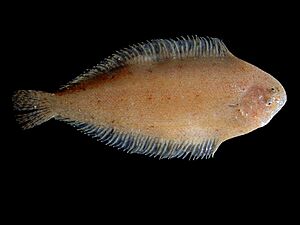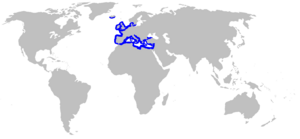Solenette facts for kids
Quick facts for kids Solenette |
|
|---|---|
 |
|
| Conservation status | |
| Scientific classification | |
| Genus: |
Buglossidium
|
| Species: |
luteum'
|
 |
|
| Range of the solenette | |
| Synonyms | |
|
|
The solenette (also called the yellow sole) is a small, flat fish. Its scientific name is Buglossidium luteum. It's the only fish in its group, or genus, which makes it quite special!
This little fish is easy to spot because of its small size, its mouth shaped like a half-circle, and the dark lines on its fins. Solenettes are common and found in many places. They live on sandy parts of the ocean floor in the northeastern Atlantic Ocean and the Mediterranean Sea. People don't usually catch them for food or sale.
Contents
Where Do Solenettes Live?
The solenette lives in the northern Atlantic Ocean, from places like Iceland and Scotland all the way south. You can also find it in the North Sea, the Kattegat, and even the Baltic Sea. It also calls the Mediterranean Sea home, including the Adriatic Sea and the Sea of Marmara.
Solenette Habitats and Depth
Solenettes are found from about 5 to 450 meters (16 to 1,476 feet) deep. However, they don't usually live in very shallow water. They are most common at depths of 5 to 15 meters (16 to 49 feet) in the English Channel. In the Bay of Biscay, they prefer depths of 20 to 35 meters (66 to 115 feet). Unlike some other flatfish, the type of sand or mud on the seafloor doesn't limit where they can live.
Solenette's Preferred Environment
This fish needs a specific kind of home. It likes waters that are a bit influenced by rivers flowing into the sea. The water needs to be salty, but not too salty, usually between 29 and 33 parts per thousand. You won't find solenettes near the mouths of very large rivers where the water is less salty. They often live on or partly buried in muddy or sandy-muddy seabeds.
What Does a Solenette Look Like?
The solenette is the smallest of the "sole" fish found in Europe. It usually grows to be about 10 to 13 centimeters (4 to 5 inches) long. The biggest solenette ever found was about 15 centimeters (6 inches) long.
Body Shape and Eyes
It has an oval-shaped body that is flat and slightly long. Like other flatfish, both of its eyes are on the right side of its head. Its snout (nose area) is round, and its upper jaw sticks out a little, like a small "beak." The upper eye is closer to the front of its head than it is to the other eye.
Fins and Scales
The solenette's dorsal fin (on its back) starts at the front of its head and has 65 to 78 fin rays (the bony supports in the fin). Its anal fin (on its belly) has 49 to 63 fin rays. The caudal fin (tail fin) is connected to the dorsal and anal fins by a small membrane. The pectoral fin on its eyed side is small, with 3 to 5 fin rays. The pectoral fin on its blind side (the side without eyes) is even smaller.
The scales along its lateral line (a special sensing line on its body) number between 55 and 70. These scales are rectangular.
Color and Camouflage
The color of the solenette's eyed side can change. It's often yellowish or light brown, sometimes with darker spots. Its dorsal and anal fins are sandy-colored, but every 5th or 6th fin ray is dark for most of its length. The solenette can change its color to blend in with the sand or mud around it, which helps it hide from predators!
Solenette Life and Habits
Adult solenettes eat many kinds of small creatures that live on the seafloor. Their favorite foods include tiny crustaceans (like copepods and amphipods), small bivalve molluscs (like clams), and polychaete worms.
What Solenettes Eat
What a solenette eats can depend on where it lives. For example, solenettes in the English Channel eat more types of prey than those in the Bay of Biscay. They also eat more worms compared to the Bay of Biscay solenettes, who eat more crustaceans and molluscs. Solenettes eat the most in the summer and much less in the winter.
Solenette Reproduction and Life Cycle
Solenettes lay their eggs at different times of the year depending on where they live. In the Mediterranean, they spawn in February. In the Bay of Biscay, it's from March to June. In the western English Channel, North Sea, and western Ireland, they spawn in July and August.
The eggs are small and special because they have only a few large oil drops inside. When the larvae (baby fish) hatch, they are about 2 millimeters (0.08 inches) long. They start to change into their adult flat shape when they are about 7 millimeters (0.28 inches) long. This change is complete when they reach 8–9 millimeters (0.31–0.35 inches).
Growing Up
Baby solenettes look similar to baby common soles. They have fewer large, star-shaped pigment spots. They also have a clear patch of pigment on their belly and a distinct head shape even when they are very young.
In the North Sea, young solenettes and adult solenettes live in the same areas. The young fish start living on the seafloor when they are about 12 millimeters (0.47 inches) long. Most of their growth happens in their first year. After that, they grow slowly and steadily. Both male and female solenettes become adults and can have babies when they are about three years old. Males grow faster than females, but females end up being bigger. The oldest solenette ever found was 13 years old!
Solenettes and People
Solenettes are too small to be important for fishing. Fishermen usually throw them back into the sea if they catch them by accident. They are sometimes caught in large numbers in fishing trawls (nets). In the past, people often confused young solenettes with young common soles.
Between 1985 and 2006, the area where solenettes live in the North Sea grew a lot. Scientists think this happened because the temperature of the seafloor water has been getting warmer.


